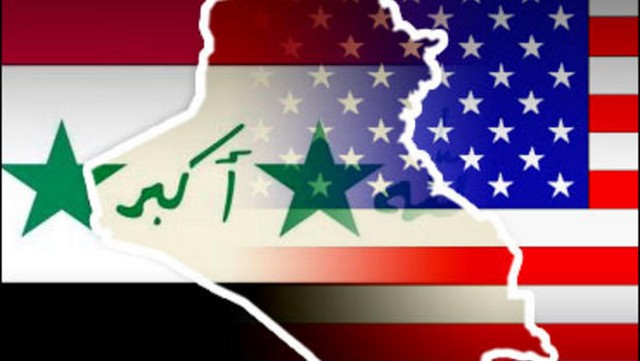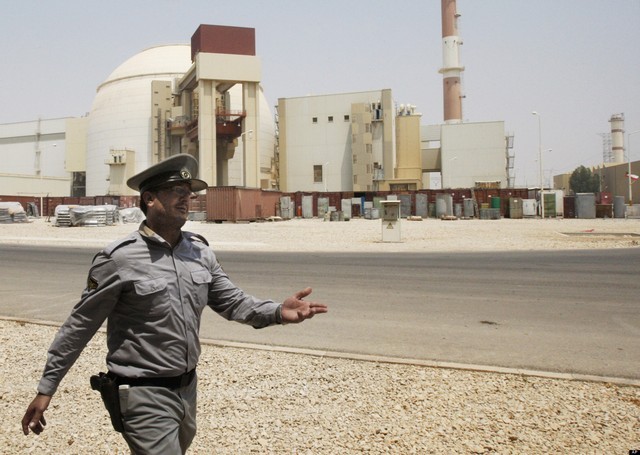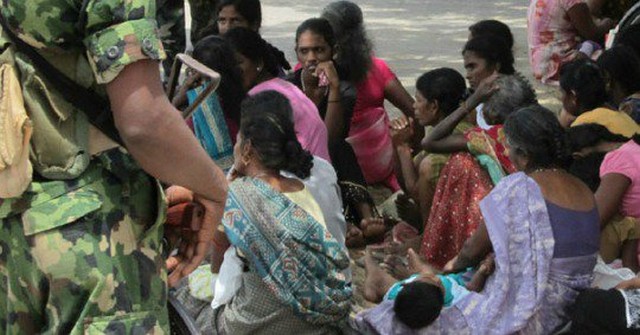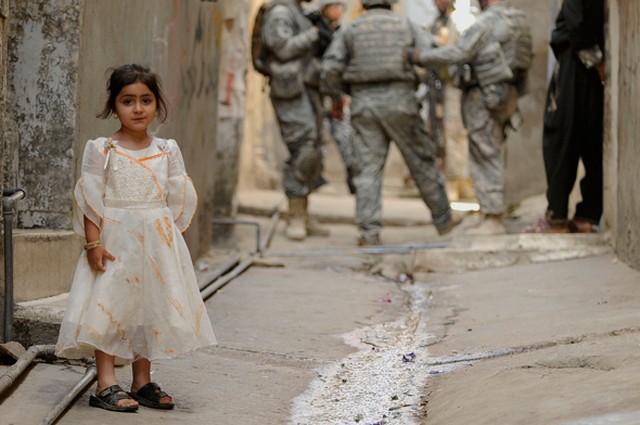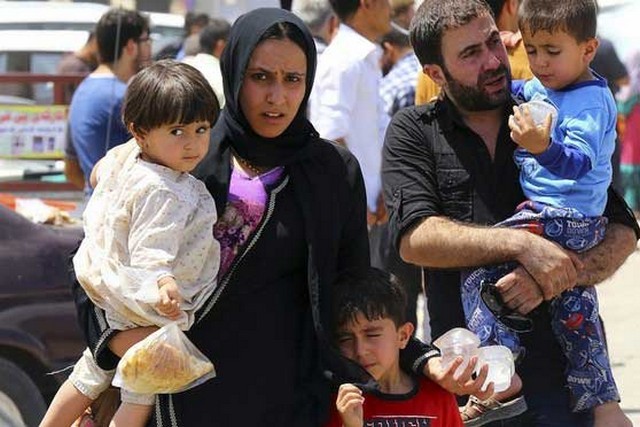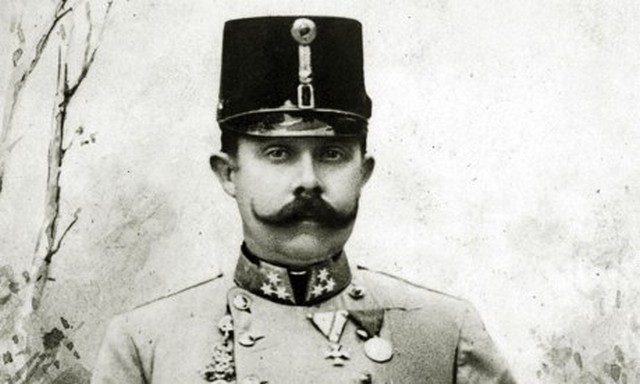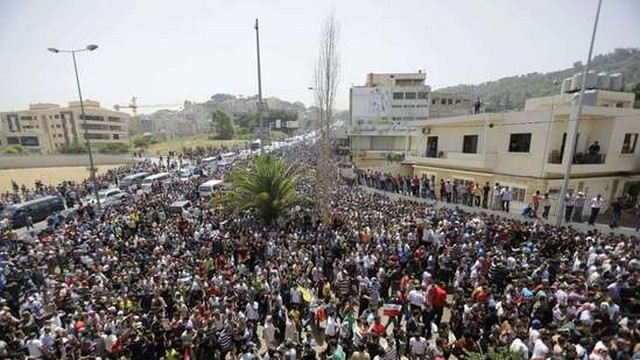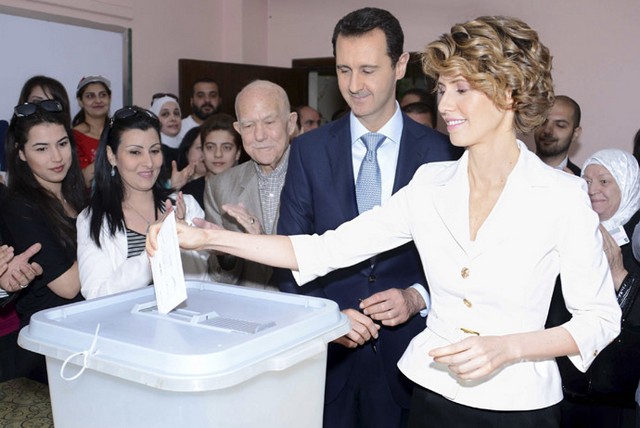By Judith Bello
I was with a group of 5 Americans, 3 Canadians and an Irishman who went to observe the Syrian election, but there were other observers from Asia, Africa and South America. On the way there, I thought about having a particular angle to report from, and I decided that since there weren’t many women observers that I would talk to other women and try to get their perspective on the election, but also on life in Syria before and after the war. I wanted to look at the issues from a less politicized perspective than most of what you hear and read on the subject of the war in Syria, and Assad’s election.
I did meet and interview number of women in Syria, and I found myself in contact with another woman when I got back, an American named Lilly Martin living in Syria with her Syrian husband. When I heard that Lilly had a house in the town of Kassab that had been destroyed during the recent period of occupation by ‘rebel’ forces (actually, al Nusra Front I think) , I wanted to know more. Kassab, an Armenian town near the Turkish border, was occupied during March of this year and only liberated by the Syrian Army a few days ago. I asked Lilly via email if she would be willing to do a written interview through email and she agreed.
Because Lilly is a middle class American and has lived much of her life in this country, her voice is familiar. She says that she had not considered herself an ‘activist’ since the Vietnam War. She says she had not thought of herself as a feminist before now. But, she says this war has changed her. Not everyone will agree with Lilly’s perspective, but it is honest, and not unfamiliar. I am very grateful to her for sharing her insights and experiences. What follows are my questions and Lilly’s answers.
Judy: How did you come to live in Syria?
Lilly: I married in 1978 in California a young kid my same age who was originally from Syria, but had migrated to USA and had left Syria in 1970. We were married and living in California from 1978 to 1994. He was in the real estate business and I was a medical professional. We had 2 sons born in CA, then moved to Syria to be close to his parents and siblings. My parents had died, and my only brother was living in Singapore teaching.
Judy: How long have you lived in Kassab and did you live in Syria before that?
Lilly: I have lived in the city of Latakia from 1994 until present. Latakia is a mid-size city, it is a beach resort for summer tourism and a Port for shipping. I visited Latakia first in 1986, then in 1990, and finally moved here in 1994. The home I lost in Kassab is my summer house, as Kassab is a high mountain village, and many people have a summer house there. Kassab is about 2000 pop and is Armenian, but the summer-house-people are of other sects. Kassab used to be a frequent summer spot for Saudi and Kuwaiti families seeking cool breezes. They would drive up from “Arabia”.
Judy: What was your life like in Kassab before the war?
Lilly : My life in Latakia from 1994 to March 2011 was wonderful. I had a great group of friends, they were all females, some Syria and some western women. We had regular meetings and I called them ‘The Ladies Club’. That ‘club’ was broken up by this war, because some of the ladies backed the ‘revolution’ and some did not. I did not, so we have never met again, after a famous Christmas party in 2011, where I simply stated, “My Christmas prayer is: God please stop the terrorists”. Half the group attacked me viciously, they said that there were no terrorists, only freedom fighters. When I said, “But, they are making bombs and throwing them everywhere indiscriminately!” They countered, “They have to defend themselves.” I never did get their logic of throwing a bomb into a shopping center in order to defend themselves.
My kids had free education, and really a good education system in both Arabic and English, mandatory. My kids went to University for FREE, which is the right of all Syria students, as long as the grades are kept up. We had free medical, hospital, surgeries, etc. Medicines were so cheap, because Syria was a large manufacturer of pharmaceuticals, with export to over 32 countries. Free education and Free medical. What more do you want?
Latakia is a easy-going place, there are no dress codes or restrictions here. Everyone got along and in 1994-March 2011 there were no uprising, no riots, no sectarian strife. The government and police were strong, so criminal activity was very low, no one had hand guns other than police and Army. No robberies, no car-jackings, no armed robbery, no bank robbery. There was regular crime, like thieves coming in when people were away, and a car theft, but nothing which involved a gun. No one had a gun.
Judy: Did you or your loved ones ever have any problem with the government in Syria
Lilly: I never had any problem with the government. My husband, and all of his family members, are NOT civil servants, or connected to the government in anyway. My husband is a self-employed businessman. We didn’t have anyone who was in prison, or in any trouble. It was my general impression that there was nothing to be afraid of, if you obeyed the laws, just I would have if I was still living in USA.
Judy: What did you think was happening at the beginning of the insurgency and where did you think it would lead?
Lilly: We all watched the revolution in Egypt. We wondered if it was coming to Syria? We all shook our heads and guessed that it would NOT. I had friends who were a couple of retired teachers from Canada, who had asked to come to visit Syria in January 2011. We all debated as to whether there could be any disturbances, and we all concluded that there was nothing going to happen. They came and we did my famous ‘walking-tour’ of Damascus. They went home and our revolution began March 2011.
From our home, watching TV we watched the coverage of Deraa March 201 unfold. Deraa is a very small and insignificant town. It is so small and remote, I would venture a guess that 90% of Syrians had never visited it. I know that the Latakian people had no relationship to Deraa, they were about 8 hours drive time between the 2 and there was no exchanges between the 2 places. Deraa was famous for archeology, and farming, and no much else.
At first, we guessed it must really be an uprising. An actual uprising of disgruntled people . People who felt oppressed or grievances of some sort. Then we wondered why were their so many soldiers and policemen being killed? How could the BBC report a soldiers funeral as coming under fire from other soldiers? That made no sense. Who were these snipers on roofs? Once they showed the Omari Mosque was a store-room for weapons, then we understood the true story. This was a foreign attack, but disguised as a popular uprising.
If it was really an uprising, then we should see it come to Latakia eventually. It did, on April 1, 2011. That was the first day. The mayor and other dignitaries went out to the protesters and asked them “WHAT” do you all want? They said in reply, “FREEDOM”. The mayor asked, “WHAT does that mean?” No reply. I saw the protesters. They were drug addicts and weird looking people, and they didn’t all look like there were even from Latakia. Out-side agitators, bused in to create trouble. However, there were some genuine intellectuals, how were duped into promoting the cause, which they later dropped when it went to armed rebellion.
People would protest, they would destroy shops, they killed innocent civilians, they killed soldiers, and police. Next came the President on TV announcing that they would abolish the emergency law, and they would send all police and soldiers to watch the protests, but strictly unarmed. The President thought that the western media was showing the Syrian police and soldiers as brutal, so by taking away the weapons, there could be no excesses. I’ll never forget that day, the day they were not allowed to carry a weapon, just to stand and watch. My friend’s son in the Police force, stood and watched, and the peaceful protesters cut him up with axes. He was buried in a plastic garbage bag. That was April 2011, from that day on we knew this was really awful, and had nothing to do with freedom or democracy.
Judy: Were you aware of a part of the population that was not being well served by the government and who could be used to spearhead a regional proxy war?
Lilly: The government in Syria was, and is secular. The President is a minority, but most of his cabinet of ministers are Sunni, the majority. The Defense Minister, who is directly responsible for the Military, was a Christian, until the terrorists blew him up in Damascus, and now he is a Sunni. The Syrian government has never been a “Alowi Elite”, or a “Minority Rule”. Those are media mantra, but are not fact.
My husband and all his relatives are Sunni, the majority, which is about 60% of the country. Alowi are about 20%, Christians are about 15%, there are about 5% which are Shite. Syria is famous for having 18 sects. The first sectarian strife was instigated by the Ottoman Turks in 1860. The second sectarian strife was 1980’s in Hama, instigated by Muslim Brotherhood. During the years I have been here there was no sectarian strife.
Every Syrian is the same under law. Corruption does exist, as it does all over the middle east, but it was dispersed among all sects. The reason for this secular government was due to the Ba’ath Party being the sole ruling party until 2012, when the new constitution abolished the one party rule. The Ba’ath party was strictly secular, and members and supporters of the Ba’ath party are among all various sects. It is still the largest and strongest party. It will take years to build confidence in other parties.
There was no “under-served, oppressed, unrepresented” portion of Syrian society. The western media mantra is the SUNNI majority rose up because they had been downtrodden too long. This is the SUNNI fantasy. My family are Sunni, and from the average types, nothing spectacular or different. There is a self-deluded paranoia here, among under-educated and bigoted Sunnis, who say all their problems are because the Alowis have all the breaks. No one asks the Sunnis why do they refuse to take advantage of the FREE education? They decided that they will do a revolution, strip everything hard earned from their minority neighbors, and then the yogurt maker will be appointed Prime Minster. This is their fantasy.
There is a huge cultural difference between Sunni families and Alowi families here on the coast, which is the Alowi highest concentration. You find the Alowi families living on an orange farm, the mother and father are tending to the trees, meanwhile their kids are studying to be a Doctor, Lawyer and Engineer. Down in the city of Latakia, you find the Sunni families complaining that their kids have to study so much, and they have to pay for private tutors because their kids are not self motivated, and want to drop out of school. These people are my relatives, and have been through 36 years of marriage. They need a lot of work, and they need to do it alone.
It was the Sunni population which fostered and participated in the rebellion. It didn’t take much outside agitation to get them into the streets and demanding that the country should be Sunni only, with all Christians shipped out to Beirut, and all Alowis slaughtered. That was the Free Syrian Army’s first banners and slogans. The Free Syrian Army was and is exclusively Sunni. If you can find one FSA soldier who is from any sect other than Sunni, I will give you $100.00 The FSA is a bigoted, sectarian terrorist group, who prays upon the uneducated, and undereducated bigoted people who want to blame all their woes on the government and their minority neighbors.
The problem with this plan of revolution was that it had very little support on the ground. The vast majority of Sunnis did not buy it or accept it or support it.
Judy: What do you think is the role of the US in the current war against Syria?
Lilly: The US is the founder, inventor and the prime driver of the attack on the Syrian people for the purpose of regime change. The CIA admits they started planning and funding this many years ago. I can understand their wish for regime change, as Syria is a pro-Palestinian resistance supporter. Those goals are not compatible with US. However, once they started their plans, and got to the point that they could see their was no ground support for the removal of the President, they should have switched gears and given up on the attack, and found another plan. But, the evil part is to continue killing innocent unarmed civilians, only because they refuse to be traitors and refuse to stop fighting terrorists. This is a moral low point for USA foreign policy.
The funding comes from Saudi Arabia, who is forced to fund by black-mail. In other words, if they don’t fund terrorism, their Royal family would be taken out over night, in the cause of human rights, and a new form of government instituted by USA. This could still happen. The Saudis have to be very docile, if they act too strong, the US will cut them down to size. The Army and military in Saudi Arabia are all in the hands of USA.
Judy: Did the people of Kassab have much social or economic commerce with people on the other side of the border in Turkey before the war?
Lilly : The border crossing at Kassab was very busy before the war. Trucks of Turkish merchandise coming in, Syrian dress shop owners going to Turkey for merchandise orders from their factories, shoes coming in from Turkey, sugar and tea going to Turkey from Syria (cheaper in Syria). The back and forth business exchanges were daily. As far as tourism, the Syrians went to Turkey all summer long on bus trips, going to shops, going to restaurants, to resorts. My own family took our summer vacation every year in Turkey. We loved it.
Judy: Were there problems with terrorists in Kassab before they took over the town a few months ago?
Lilly : The road from Latakia to Kassab had remained open all during the war. People were constantly coming and going between the 2 all during the war. Even on March 21, the day of invasion, there were people in Kassab visiting there. There was a place to the EAST of Kassab, towards Idlib, Qasta Maaf, Selma, Ferloq, Rabia, all those areas to the EAST of Kassab had experienced problems with terrorists. But, the coast and Kassab were OK and there had been no previous attacks. It was a shock and mystery why they would burst into Kassab on March 21, 2014. I still don’t see the military target or strategy. From the other side, I can’t see why they did it. Massacring 88 unarmed civilians and beheading 13. Why? For what reason? Because they were Christians?
Judy: Were there internal divisions in or around Kassab where people were taking divisive political or military stances within the community?
Lilly : There was nothing whatsoever political going on in Kassab. 2,000 Armenians, Syrian citizens, who are Christian. They were all small farmers, apples and peaches. Some owned tiny grocery shops, some owned hand soap factories, small sized, for the production of Olive Oil and Bay leaf hand soap bars. There were no parties, no protests, nothing. The Syrian Christians are all of one mind, which is in support of peace, safety, support of the government. I have never seen any Syrian Christian say anything about supporting any rebellion. There could be some Syrian Christians in USA who may be supporting regime change, but not inside Syria. Christians here see the rebellion as 100% Sunni and they have no place in it.
Judy : Were people killed when Kassab was overrun or did most people escape before the terrorists came in?
Lilly: 6 am, March 21, 2014 the terrorists burst in, according to survivors (I have their names and testimony) the terrorists were a combination of foreigners, with a few Syrians included. This would be classic Free Syrian Army. They are Syrians working with various Al Qaeda. 88 unarmed civilians killed immediately, with 13 of those beheaded. The survivors ran to Latakia in cars, etc. The survivors are still sleeping here at the Armenian church in Latakia (I spoke by cell phone to their media person this morning) 22 very elederly survivors were kidnapped and taken by force to Turkey, were they were treated well in a small village 23 kilometers north of Kassab. 11 of them have been brought back to Latakia, via Lebanon and we are waiting for the other 11.
Judy: Have you been suffering other problems due to the war before or since the terrorist invasion of Kassab? Have there been shortages of food or gas and oil, for instance.
Lilly: Since the war began, March 2011, the prices of normal everyday items of life have risen by 8 times. If an item had cost 100 lira, it is now 800 lira. I am referring to everything you eat, drink, or clothes. Many medicines are no longer available. You would have to go to Lebanon to find them, and at US prices. Gas, food and supplies are available, but at prices many can not bear. Syria has never had a welfare program, like money given to the poor. So the poor are suffering.
For example: my husband sells bulldozers. He has not sold one bulldozer since March 2011. We have been living off savings, with no income at all in this period. We are a typical family. Government employees still have their paychecks, so this helps many. Self employed people have been hit, and especially factory workers, since all the various factories were destroyed by FSA.
At certain times we were staying inside city limits, it was too dangerous to travel. Right now, the roads from Latakia to Homs to Damascus are all open and OK. There is no travel from Latakia to Aleppo, that is all terrorist lands.
Judy: What are the conditions under which refugees in Latakia live?
Lilly: The survivors of Kassab have been and still are sleeping at the Armenian church in Latakia. The church is modern and has water, kitchen, toilets and plenty of space. It is a church, school and cultural center all in one. It was renovated about 5 years ago, thank God for that, it has been put to use. The refugees are well cared for and have funds donated and are OK for the persent, but they will need a lot to repair and rebuild their homes in Kassab. Many homes have been looted and destroyed. Some are burnt up, some demolished.
Judy: How have the conditions of the war affected the circumstances of women and children in general in Syria?
Lilly: Women and children have suffered a great deal. But the biggest suffering has been those that LEFT Syria to stay in Turkey, Lebanon and Jordan. I will discuss the females and kids outside of Syria later with you. The suffering of those inside Syria, internally displaced, has been real, but not much more than males. We have many internally displaced refugees from Aleppo here in Latakia. They have food, shelter, medicines, and the kids are all in school. They are suffering because they can’t go home. They can’t have a normal income.
Judy: I saw a lot of martyrs images in and around Tartous when I was there . Are many of the men in your community engaged in the fighting as members of the military?
Lilly: The Syrian Army was ranked #16 in the world prior to the war. It consisted of 600,000 soldiers. I know many have died, the official count is 25,000 soldiers dead. The Syrian Army consists of young men 18 and over, healthy and not currently enrolled in University. It is a compulsory duty. The Syrian Army soldiers are from all 18 different sects. They are not “Assad loyalist” any more that the US military are “Obama regime loyalist”. Uniformed soldiers in a national Army are fighting for their country and family, but not necessarily for their leader or political ideology. The typical American soldier and the typical Syrian soldier are similar. You wear and uniform and shoot a gun and no one ever asks you for your political analysis.
The Syrian soldiers who have died in the war are from every family in every community across Syria. Everyone has lost someone.
Judy: How did you feel about the election? What are your thoughts on Bashar Assad’s continued Presidency?
Lilly: I was very excited about the election, I observed my local poll and took photos and wrote a report. I had been expecting the current President to make a big move toward free elections back in 2007. I could tell when he came to office in 200 he wanted to make changes. He was very slow, but I am sure he had advisors who cautioned to go slow. Syria is so conservative, they move slow. I know that the majority of people support him.
There are people who boycotted the election, they are mainly these bigoted, sectarian types. If they wanted a Sunni President, they could have all voted for Dr. Hassan al Nouri, but only 500,000 did. If you ask any of the revolutionaries who do they want leading, they have no candidate, no ideas, no goals. They are just dead-heads as far as I am concerned. All they needed to do was to present a vision of what they wanted for Syria should the regime fall. If their vision proposed was acceptable to many, it would have happened. But they never had a vision, or any plan. They are the blind leading the blind and wondering why everyone voted for President Assad.
Judy: Do you feel safe going home?
Lilly: I won’t feel safe returning to Kassab, to check on my home there, until all the Armenians go. I will tag-along with them. I would be afraid of left over bombs, or dead bodies laying around. I am a bit afraid really. But at some point the all clear will be given and I will go. I have to.
Judy: Will you be given any assistance with rebuilding?
Lilly: The government has already said there will be funds provided for rebuilding the whole of the country. The exact amounts, and how and when, those are in the works. Syria entered into the war with zero debts. They have paid for many weapons and various supplies, they were not given any gifts, they paid for everything, but still have not taken any loans from anyone. This was their goal, to be able to spend their own money without asking for loans, which could make you feel tied up later, beholden.
Judy: Is there anything else you would like to share with people about what is going on in Syria right now?
Lilly: The main thing is for the various countries funding and supporting the attack on Syria to stop. That means the London 11 group (formerly known as the Friends of Syria) should be dissolved. There should be no more paychecks and weapons sent to terrorists to fight inside Syria. The Rat Line from Benghazi to Iskenderun, Turkey should be shut. The borders along Turkey, Iraq, Lebanon and Jordan should be well guarded and terrorists should be prevented from coming in. if the various sponsors and supporters will stop immediately, Syrian can slowly recover, clean up and re-build. In the consideration of humanitarian issues, I would ask that all nations formerly against Syria cease and desist and let’s discuss ways to make Syria a better place through the UN and other peaceful means.
Judy Bello has traveled to Iran, Iraq, Pakistan and now Syria seeking to bridge cultural barriers to understanding and network with others to build a more peaceful and more just society.
17 June, 2014
Countercurrents.org


